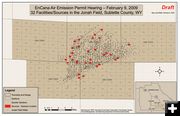

Drilling Locations
Map showing location of drilling in the Jonah Field. EnCana wells related to this permit change request are shown in red. Map by the Wilderness Society.
|
|
DEQ holds Public Hearing on EnCana permit change requests
Citizens express continued concern over ozone air pollution in the Upper Green River Basin and health concerns
by Dawn Ballou, Pinedale Online!
February 10, 2009
Wyoming DEQ held a public hearing at Rendezvous Pointe in Pinedale on Monday, February 9th. The purpose of the hearing was to get public testimony regarding a request by EnCana Oil and Gas (USA) for permit changes on 32 of the company's gas-condensate production facilities in the Jonah field. The company says the change will reduce volatile organic compounds emissions while increasing nitrogen oxides emissions at some production facilities.
EnCana has put millions of dollars into efforts to reduce and control air pollution emissions. The company’s position is that emission reductions can be achieved while continuing to develop the Jonah Field.
Citizens giving testimony expressed concerns over lack of sufficient scientific data and understanding of why ozone is occurring in the winter months in the Upper Green River Valley. There were continued calls to slow the pace of drilling until scientific data is obtained to assure development is done in a way that does not harm the environment or human health.
While ozone is a colorless gas, citizens pointed to the "brown cloud" that frequently hangs over the Pinedale Anticline and Jonah gas fields as visible proof of the deteriorating air quality of the Upper Green River Basin being caused by drilling activity. Concerns were also expressed about other drilling-related compounds being released in the air and ground water.
In the winter of 2008, Wyoming DEQ issued five air quality ozone advisories for the Upper Green River Valley. Advisories were issued on February 27, and March 10, 11, 23 and 24th. Ozone levels exceeded government standards of multiple occasions during the winter months causing considerable public alarm and outrage over the air quality degradation in the Upper Green River Valley. According to DEQ, emissions from natural gas drill rigs and compression stations in the area were blamed as being the largest sources for nitrous oxide (NOx) and volatile organic compound (VOC) chemicals which combine to form ozone. Monitoring data has shown elevated levels of ozone in three of the last four winters.
This year, DEQ issued air quality advisories on February 3 and 4, 2009. According to Finley, ozone levels did not go above 75 parts per billion on either of those days, however they did get some short spikes in the 80, 90s and 95 ppb range. "None of the one hour or 8-hour values went above 75ppb," DEQ Air Quality Director Dave Finley said.
DEQ will consider the testimony and do a written evaluation and make a written decision on EnCana’s permit change requests.
|
